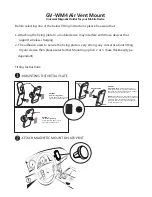
30
31
5
Do not take notes or look up phone numbers
while driving. Jotting down a “to do” list or
flipping through your address book takes
attention away from your primary responsibility,
driving safely.
6
Dial sensibly and assess the traffic; if possible, place
calls when you are not moving or before pulling into
traffic. Try to plan calls when your car will be stationary.
If you need to make a call while moving, dial only a
few numbers, check the road and your mirrors, then
continue.
7
Do not engage in stressful or emotional conversations
that may be distracting. Make people you are talking
with aware you are driving and suspend conversations
that have the potential to divert your attention from
the road.
8
Use your wireless phone to call for help. Dial 9-1-1
or other local emergency number in the case of fire,
traffic accident or medical emergencies. Remember, it
is a free call on your wireless phone!
9
Use your wireless phone to help others in
emergencies. If you see an auto accident,
crime in progress or other serious emergency
where lives are in danger, call 9-1-1 or other
local emergency number, as you would want
others to do for you.
10
Call roadside assistance or a special non-
emergency wireless assistance number when
necessary. If you see a broken-down vehicle
posing no serious hazard, a broken traffic
signal, a minor traffic accident where no one
appears injured, or a vehicle you know to
be stolen, call roadside assistance or other
special non-emergency number.
“The wireless industry reminds you to use your
phone safely when driving.”
For more information, please call 1-888-901-SAFE, or visit
our web-site www.wow-com.com
Provided by the Cellular Telecommunications & Internet
Association
Health and safety information
Operating Environment
Remember to follow any special regulations in force in
any area and always switch your phone off whenever it
is forbidden to use it, or when it may cause interference
or danger. When connecting the phone or any accessory
to another device, read its user’s guide for detailed safety
instructions. Do not connect incompatible products.
As with other mobile radio transmitting equipment,
users are advised that for the satisfactory
operation of the equipment and for the safety of
personnel, it is recommended that the equipment
should only be used in the normal operating
position (held to your ear with the antenna
pointing over your shoulder).
Using Your Phone Near Other
Electronic Devices
Most modern electronic equipment is shielded from
radio frequency (RF) signals. However, certain electronic
equipment may not be shielded against the RF signals
from your wireless phone. Consult the manufacturer to
discuss alternatives.
Pacemakers
Pacemaker manufacturers recommend that a minimum
distance of 15 cm (6 inches) be maintained between
a wireless phone and a pacemaker to avoid potential
interference with the pacemaker.
These recommendations are consistent with the
independent research and recommendations of Wireless
Technology Research. If you have any reason to suspect
that interference is taking place, switch off your phone
immediately.







































